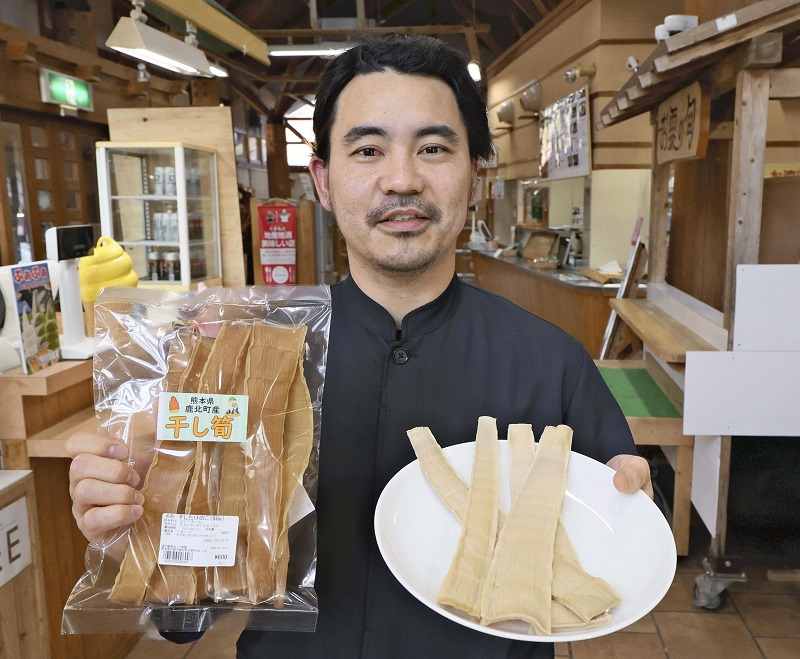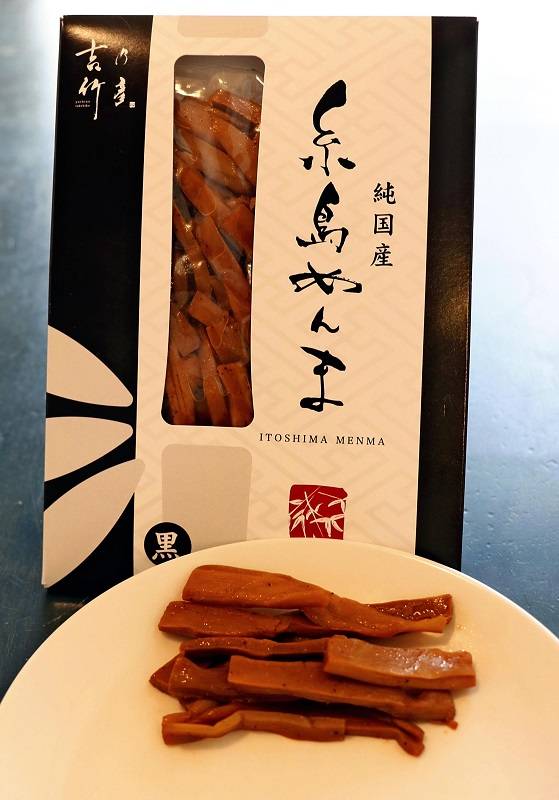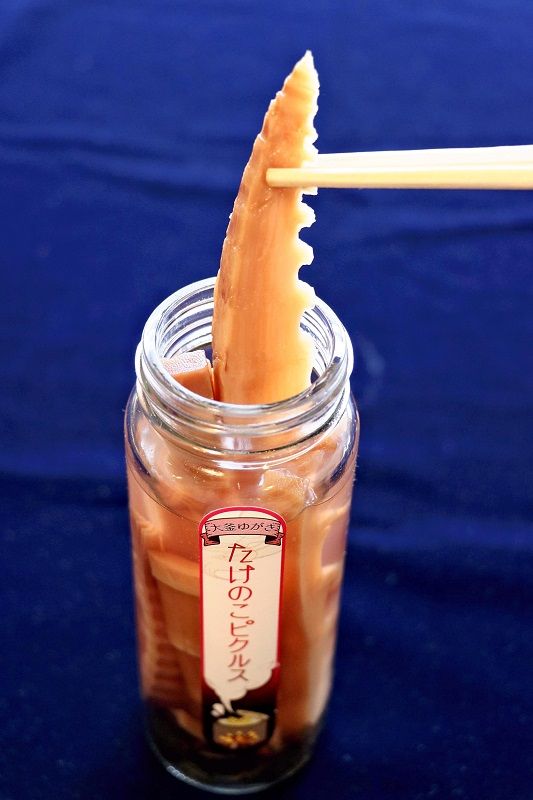
Kazuki Sunagawa holds a pack of dried bamboo shoots and a plate of rehydrated ones at a restaurant in Yamaga, Kumamoto Prefecture.
17:02 JST, May 24, 2022
FUKUOKA — Takenoko bamboo shoots are generally a boiled delicacy enjoyed in the spring. However, there are a wide variety of processed bamboo shoot products available year-round.
One such product comes from a city in Kumamoto Prefecture whose residents traditionally dry the shoots, giving them a distinctive flavor and texture.
The Kahoku district in Yamaga, Kumamoto Prefecture, is known as a major production area of bamboo shoots. At the Michi-no-Eki Kahoku Ogurigo rest area, there are packages of locally sourced dried bamboo shoots lining the shelves. At first glance, they look just like tree bark.
“Contrary to their appearance, dried bamboo shoots taste really good,” said Kazuki Sunagawa, manager of a restaurant at the rest area.
The Kyushu region’s mild climate provides a suitable environment for growing bamboo shoots, and dried takenoko is rarely found in other parts of Japan.
“The drying process helps enhance the flavor of the bamboo shoots,” Sunagawa said.
In addition to its distinctive and satisfyingly tough texture, dried bamboo shoots also have a rich umami flavor, which is not something that can be tasted when fresh takenoko is boiled.
An 80-gram package of dried takenoko costs about ¥500. To rehydrate the bamboo shoots, they need to be soaked in cold or lukewarm water for five to six hours. They will swell to about five times their original size.
After the shoots are completely rehydrated, fill a pot with water and bring it to a boil. Once the water is boiling, add the shoots and bring it to a low heat to cook them for one to two hours until soft. If you are using a pressure cooker, it takes about 20 minutes.
Turn off the heat when the takenoko becomes soft enough. When the shoots have cooled, cut them into smaller pieces to use. They are typically cooked with rice, simmered with other ingredients or sauteed as kinpira.

Clockwise from top left, omelet with tartar sauce, a kinpira saute, a simmered vegetable dish and cooked rice, all using dried bamboo shoots and prepared by Kazuki Sunagawa
“Fresh bamboo shoots are delicious when they’re in season, but the dried ones have a different flavor,” said a homemaker in her 70s from Kahoku. “When I stir-fry [rehydrated shoots], they basically disappear as soon as they’re served.”
Dried bamboo shoots are increasing in popularity outside of Kyushu as a result of their rich flavors. Now, they are being incorporated into more recipes, such as curry, soup, pasta and hot pot dishes.
Sunagawa, who used to work as a chef at a French restaurant, moved to Kahoku because he found the local food and nature of Kumamoto Prefecture fascinating. While developing new dishes for the restaurant at the rest area, Sunagawa would sometimes use dried bamboo shoots. He has now been thinking of ways to use dried takenoko in some Western-style foods and sauces, such as tartar sauce.
“As they can go well with various ingredients, I hope people will try them, not just with Japanese dishes, but with Western ones as well,” he said.
Protecting forests
Menma, commonly known as a ramen topping, is a product made by boiling, fermenting and then drying bamboo shoots. While most of the menma sold in Japan are made from bamboo shoots imported from China and Vietnam, there are a number of projects underway to produce menma using local takenoko harvested from unmanaged bamboo forests to prevent the land from deteriorating.

Takeman’s menma uses takenoko harvested from unmanaged bamboo forests in Itoshima, Fukuoka Prefecture.
One such company, Takeman, based in Itoshima, Fukuoka Prefecture, has been producing menma using takenoko from unmanaged forests in the city since 2015. Named Itoshima Menma, the product comes in Kuro (black) flavor, as it is seasoned with soy sauce and sugar, and Aka (red) flavor, which is mixed with chili oil and tastes like tonkotsu pork broth. Itoshima Menma costs ¥594 per 100-gram pack.
According to Takeman, the texture of locally made menma is slightly crispier than the imported ones.
Onga Gundan, a group based in Nakama in the prefecture, which is working to revitalize the city and surrounding areas, has been selling Menma no Tora (the tiger of menma) since September 2019. Menma no Tora, which is seasoned by Takeman, is also made from locally sourced bamboo shoots and is sold for ¥500 per 100 grams.
“We hope we can help solve local issues through the production of menma,” said Takeman President Yuko Yoshino.
Pickled pink
Bamboo shoots are also delicious when they are pickled in vinegar.

Pickled takenoko that was jointly developed by a Michi-no-Eki rest area and an agricultural high school in Yame, Fukuoka Prefecture
The Michi-no-Eki Tachibana in Yame, Fukuoka Prefecture, has developed a pickled product using locally sourced takenoko in collaboration with an agricultural high school in the city. The pickled takenoko, which costs ¥600 per 75 grams, is light pink as a result of being soaked with red shiso leaves, in addition to plum vinegar, kombu broth, salt and sugar. The product won an award in a competition for processed food organized by the prefectural government in fiscal 2019.
“We hope people will enjoy takenoko all year round with the refreshing flavor of pickled takenoko,” said an official at the rest area.
"Features" POPULAR ARTICLE
-

Sanrio to Open Museum in Yamanashi Pref. Dedicated to Founder, Exhibits Include Hello Kitty, Other Characters
-

Autumn Foliage Surrounds Visitors to Tokyo’s Showa Kinen Park
-

My Daughter No Longer Speaks to Me, But I Want to See Her and My Grandchild
-

Kumamoto: Public Bath Refurbished as Library Where You Can Chat, Take Photos
-

Frozen Vegetables: Demand Rises for Convenient, Tasty Domestic Produce
JN ACCESS RANKING
-

Keidanren Chairman Yoshinobu Tsutsui Visits Kashiwazaki-Kariwa Nuclear Power Plant; Inspects New Emergency Safety System
-

Imports of Rare Earths from China Facing Delays, May Be Caused by Deterioration of Japan-China Relations
-

University of Tokyo Professor Discusses Japanese Economic Security in Interview Ahead of Forum
-

Japan Pulls out of Vietnam Nuclear Project, Complicating Hanoi’s Power Plans
-

Govt Aims to Expand NISA Program Lineup, Abolish Age Restriction























